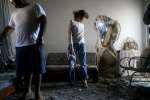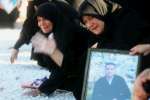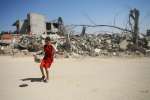Return to Somalia: No longer a refugee
News Stories, 7 August 2015
MOGADISHU, Aug 7 (UNHCR) – The flight took just one hour, but for 26 year old Fatuma and the 115 Somalis on board, it was the journey of a lifetime.
They have been living in exile for years, hosted in Dadaab, the world's largest refugee camp located in a remote corner of northeastern Kenya.
On 5 August 2015, they went back home to Somalia. Fatuma returned to the Somali capital Mogadishu as a mother, bringing with her Fardowsa, born in May 2013 in the refugee camp where she lived for three years.
Dadaab has been a safe haven for refugees from Somalia, since it was initially set up in 1991 when civil war broke out in Somalia. Planned to host around 90,000 people, the complex of five camps has grown dramatically over the years, reflecting the reality on the other side of the border.
In Somalia, prolonged armed conflict compounded by consequences of recurring natural hazards, have forced millions to move in search of survival and protection. Today, 333,000 refugees make up the refugee population in Dadaab with the vast majority being from neighbouring Somalia – a country within which more than one million people continue to live in displacement.
Returning home, to areas people once fled from in Somalia, is a trend gaining ground over the past three years. More than 60,000 internally displaced have been supported by UNHCR and its partners to return to their areas of origin since mid-2012, and voluntary repatriation has picked up since a framework offering support to safe, dignified and sustainable returns was agreed on in 2013.
The Tripartite Agreement signed in November 2013 between UNHCR and the Governments of Kenya and Somalia, constitutes a framework to ensure that repatriation must be safe and dignified and fully voluntary.
Close to 2,600 Somali refugees decided to leave Kenya and return to their areas of origin in Somalia in the course of a seven-month Pilot Phase from December 2014 during which UNHCR provided repatriation and reintegration support.
Fatuma and the 115 refugees onboard of the plane from Dadaab, are the first refugees to return to Somalia since a new and enhanced repatriation programme was endorsed by the Tripartite Commission on 29 July.
From the dusty plains of Dadaab, they cruised over troubled areas of South Central Somalia where they could not go by road. Soon after, the plane prepared for landing in Mogadishu, along a beautiful stretch of coastline where Somalia meets the Indian Ocean.
On the ground waiting were several Somali government representatives eager to meet and greet the returnees. The UNHCR-sponsored flight allowed the group of now former refugees to return home despite the still fragile security situation in parts of their country. Future refugee returns will continue to be primarily by road, and only the most vulnerable will be airlifted from Kenya to Somalia.
In Dadaab, Fatuma ran a small kiosk and will now start looking for some start up assistance for a shop in Mogadishu to earn a living. Fatuma and her daughter are fortunate to have a home to return to. They will move into the house of her mother and sister, and wait for the return of her husband who is in South Africa. Other returnees, especially those who have been away from Somalia for many years, often need to start all over building once more a foundation for their lives and livelihoods.
UNHCR supports returnees to return and reintegrate in their areas of origin where an increasing number of rehabilitation and development projects are ongoing. The joint aim for these projects undertaken by UN agencies in collaboration with federal and regional government authorities, is to restore and create access to water, sanitation and basic services. For many, however, the choice to go back remains difficult, when their longing to return to their roots is overshadowed by fear of insecurity, continued conflict and lack of access to jobs, schools, hospitals and other essential facilities that are not yet in place.
While some – including the governments of Kenya and Somalia – argue that the returnees are part of the solution to rehabilitate and stabilize Somalia, many refugees in Kenya want to first see conditions in their home country that are more conducive to their return.
On board the plane from Dadaab was also Hureji Osman Siat, 72. She did not want to wait any longer to return. Hureji Osman Siat was on the plane with her daughter and several grandchildren, one of them a boy with a physical disability. In Dadaab, she was working with Handicap International and wants to continue working to serve her people through humanitarian work, she says.
Hureji Osman Siat left Mogadishu in 2008 and her house then located in a central part of the city. She returns without yet knowing where she and the rest of the family will settle. Most of the relatives are still in Dadaab, but Hureji Osman Siat says that their plan is to contact former neighbours to help them find a place to stay.
All she carries is 20 kilos of luggage, and a heart and mind full of hope. "I am happy to be back even if I have to sleep under a tree, because returning to Mogadishu is what I have been thinking about for a long time," she says.
By Alexandra Strand Holm Nairobi/Mogadishu












































